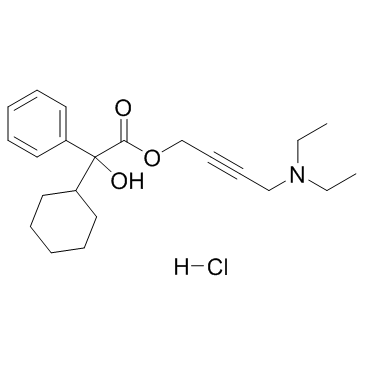Oxybutynin chloride

Oxybutynin chloride structure
|
Common Name | Oxybutynin chloride | ||
|---|---|---|---|---|
| CAS Number | 1508-65-2 | Molecular Weight | 393.947 | |
| Density | N/A | Boiling Point | 494.4ºC at 760 mmHg | |
| Molecular Formula | C22H32ClNO3 | Melting Point | 126-128ºC | |
| MSDS | Chinese USA | Flash Point | N/A | |
| Symbol |

GHS07 |
Signal Word | Warning | |
|
Developing structure-activity relationships for the prediction of hepatotoxicity.
Chem. Res. Toxicol. 23 , 1215-22, (2010) Drug-induced liver injury is a major issue of concern and has led to the withdrawal of a significant number of marketed drugs. An understanding of structure-activity relationships (SARs) of chemicals can make a significant contribution to the identification o... |
|
|
A predictive ligand-based Bayesian model for human drug-induced liver injury.
Drug Metab. Dispos. 38 , 2302-8, (2010) Drug-induced liver injury (DILI) is one of the most important reasons for drug development failure at both preapproval and postapproval stages. There has been increased interest in developing predictive in vivo, in vitro, and in silico models to identify comp... |
|
|
Chemical genetics reveals a complex functional ground state of neural stem cells.
Nat. Chem. Biol. 3(5) , 268-273, (2007) The identification of self-renewing and multipotent neural stem cells (NSCs) in the mammalian brain holds promise for the treatment of neurological diseases and has yielded new insight into brain cancer. However, the complete repertoire of signaling pathways ... |
|
|
Genetic mapping of targets mediating differential chemical phenotypes in Plasmodium falciparum.
Nat. Chem. Biol. 5 , 765-71, (2009) Studies of gene function and molecular mechanisms in Plasmodium falciparum are hampered by difficulties in characterizing and measuring phenotypic differences between individual parasites. We screened seven parasite lines for differences in responses to 1,279... |
|
|
Investigating detrusor muscle concentrations of oxybutynin after intravesical delivery in an ex vivo porcine model.
J. Pharm. Sci. 104 , 2233-40, (2015) Intravesical oxybutynin is highly effective in the treatment of overactive bladder. Traditionally the mechanism of action was explained by antagonism of muscarinic receptors located in the detrusor, however evidence now suggests antimuscarinics may elicit the... |
|
|
An overview on mixed action drugs for the treatment of overactive bladder and detrusor overactivity.
Urol. Int. 89(3) , 259-69, (2012) To provide an overview on the efficacy, tolerability, safety and health-related quality of life (HRQoL) of drugs with a mixed action used in the treatment of overactive bladder (OAB).MEDLINE database and abstract books of the major conferences were searched f... |
|
|
Pharmacokinetics and toxicity of antimuscarinic drugs for overactive bladder treatment in females.
Expert Opin. Drug Metab. Toxicol. 8(11) , 1387-408, (2012) Antimuscarinics (AMs) are the mainstay of pharmacological treatment of overactive bladder (OAB), a symptom complex defined by the presence of urinary urgency, usually associated with frequency and nocturia, with or without urgency urinary incontinence. The AM... |
|
|
An evaluation of patient and physician satisfaction with controlled-release oxybutynin 15 mg as a one-step daily dose in elderly and non-elderly patients with overactive bladder: results of the STOP study.
Curr. Med. Res. Opin. 28(8) , 1369-79, (2012) Evaluate patient and physician satisfaction with a novel formulation of a once-daily controlled-release (CR) oxybutynin (Uromax*) 15-mg tablet as both the initial and maintenance dose in elderly and non-elderly patients with overactive bladder (OAB).Patients ... |
|
|
Early administration of oxybutynin improves bladder function and clinical outcomes in newborns with posterior urethral valves.
J. Urol. 188(4 Suppl) , 1516-20, (2012) Abnormal bladder function following posterior urethral valve ablation can lead to deleterious effects on renal function and urinary continence. We performed a pilot study to determine if bladder dysfunction could be ameliorated by the early administration of ... |
|
|
What is the success of drug treatment in urge urinary incontinence? What should be measured?
Arch. Gynecol. Obstet. 287(3) , 511-8, (2013) The aim of this study is to evaluate the efficacy and the tolerability of three classic antimuscarinic drugs used in the treatment of over active bladder syndrome using clinical data and quality of life tests, and to evaluate the parameters affecting the succ... |